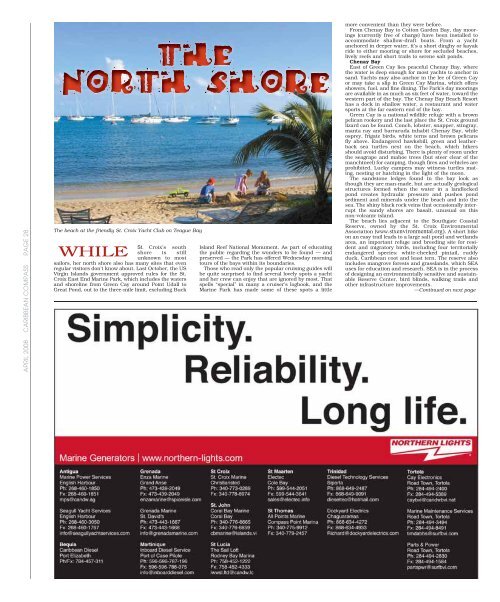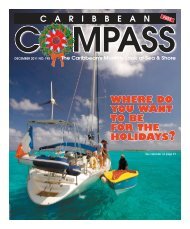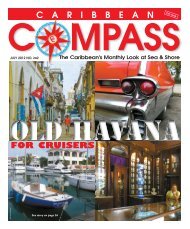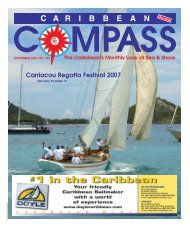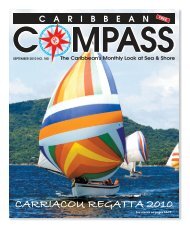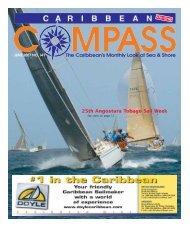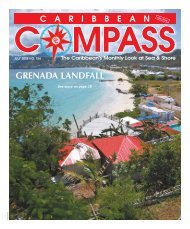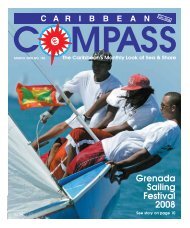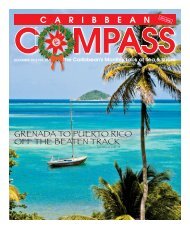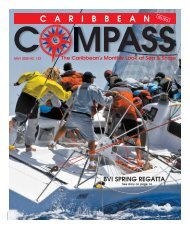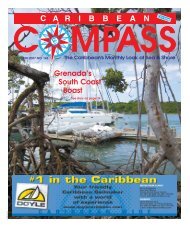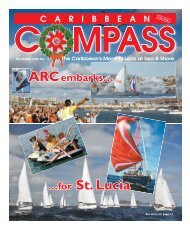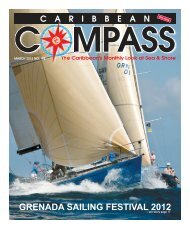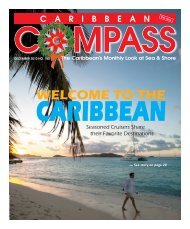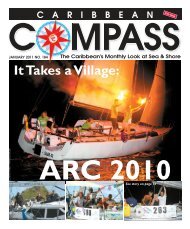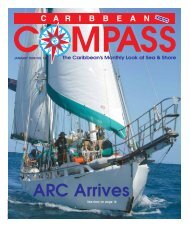Bequia Easter Regatta 2008 - Caribbean Compass
Bequia Easter Regatta 2008 - Caribbean Compass
Bequia Easter Regatta 2008 - Caribbean Compass
Create successful ePaper yourself
Turn your PDF publications into a flip-book with our unique Google optimized e-Paper software.
APRIL <strong>2008</strong> CARIBBEAN COMPASS PAGE 28<br />
The beach at the friendly St. Croix Yacht Club on Teague Bay<br />
WHILE St. Croix’s south<br />
shore is still<br />
unknown to most<br />
sailors, her north shore also has many sites that even<br />
regular visitors don’t know about. Last October, the US<br />
Virgin Islands government approved rules for the St.<br />
Croix East End Marine Park, which includes the waters<br />
and shoreline from Green Cay around Point Udall to<br />
Great Pond, out to the three-mile limit, excluding Buck<br />
Island Reef National Monument. As part of educating<br />
the public regarding the wonders to be found — and<br />
preserved — the Park has offered Wednesday morning<br />
tours of the bays within its boundaries.<br />
Those who read only the popular cruising guides will<br />
be quite surprised to find several lovely spots a yacht<br />
and her crew can enjoy that are ignored by most. That<br />
spells “special” in many a cruiser’s logbook, and the<br />
Marine Park has made some of these spots a little<br />
more convenient than they were before.<br />
From Chenay Bay to Cotton Garden Bay, day moorings<br />
g (currently ( free of charge) have been installed to<br />
accommodate accommoda shallow-draft boats. From a yacht<br />
anchored in deeper water, it’s a short dinghy or kayak<br />
ride to either eithe mooring or shore for secluded beaches,<br />
lively reefs aand<br />
short trails to serene salt ponds.<br />
Chenay Bay B<br />
East East of Gr Green Cay lies peaceful Chenay Bay, where<br />
the water is<br />
deep enough for most yachts to anchor in<br />
sand. Yacht Yachts may also anchor in the lee of Green Cay<br />
or may take<br />
a slip in Green Cay Marina, which offers<br />
showers, fue fuel, and fine dining. The Park’s day moorings<br />
are available<br />
in as much as six feet of water, toward the<br />
western part<br />
of the bay. The Chenay Bay Beach Resort<br />
has a dock<br />
in shallow water, a restaurant and water<br />
sports at the<br />
far eastern end of the bay.<br />
Green Cay is a national wildlife refuge with a brown<br />
pelican rookery rook and the last place the St. Croix ground<br />
lizard can be found. Conch, lobster, snapper, stingray,<br />
manta ray aand<br />
barracuda inhabit Chenay Bay, while<br />
osprey, friga frigate birds, white terns and brown pelicans<br />
fly above. EEndangered<br />
hawksbill, green and leather-<br />
back sea turtles tu<br />
nest on the beach, which hikers<br />
should avoid disturbing. There is plenty of room under<br />
the seagrape and mahoe trees (but steer clear of the<br />
manchineel) for camping, though fires and vehicles are<br />
prohibited. Lucky campers may witness turtles mating,<br />
nesting or hatching in the light of the moon.<br />
The sandstone ledges found in the bay look as<br />
though they are man-made, but are actually geological<br />
structures formed when the water in a landlocked<br />
pond creates hydraulic pressure and pushes pond<br />
sediment and minerals under the beach and into the<br />
sea. The shiny black rock veins that occasionally interrupt<br />
the sandy shores are basalt, unusual on this<br />
non-volcanic island.<br />
The beach lies adjacent to the Southgate Coastal<br />
Reserve, owned by the St. Croix Environmental<br />
Association (www.stxenvironmental.org). A short hike<br />
on an easy trail leads to a large salt pond and wetlands<br />
area, an important refuge and breeding site for resident<br />
and migratory birds, including four territorially<br />
endangered species: white-cheeked pintail, ruddy<br />
duck, <strong>Caribbean</strong> coot and least tern. The reserve also<br />
includes mangrove forests and grasslands, which SEA<br />
uses for education and research. SEA is in the process<br />
of designing an environmentally sensitive and sustainable<br />
Reserve Center, bird blinds, walking trails and<br />
other infrastructure improvements.<br />
—Continued on next page


